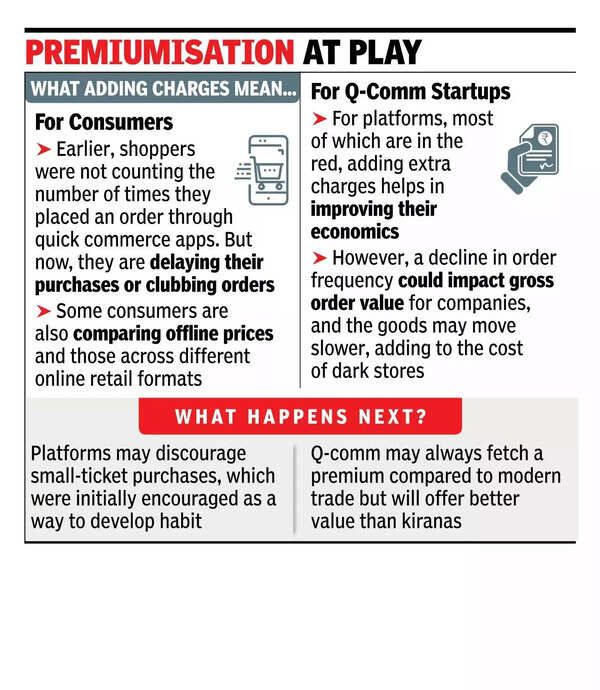How much would you pay for 10-min delivery?

Having groceries delivered at your doorstep home in 10 minutes is very convenient for people especially in metro cities. Shopping on quick commerce apps has become a habit for many, but a section of consumers has started to feel the pinch of instant deliveries.Platforms such as Swiggy Instamart, Blinkit, and Zepto, which control the bulk of the market, are adding a range of fees to the bill, due to which consumers are shelling out up to Rs 50 extra every time they place an order.Price Comparison Is BackTo begin with, consumers have to pay a handling charge, which is fixed for every order and ranges between Rs 10-21. Add GST, delivery charge, small cart fee, rain fee, and surge fee (when applicable), and the bill gets inflated. While it doesn’t mean that people don’t want to pay for convenience, many consumers have started planning their purchases once again. They are now comparing offline prices and those across different e-tail formats before shopping on quick commerce platforms.

Also, the leverage of better pricing the platforms initially had over kiranas and local vendors seems to be getting eroded due to the fee structure. “I buy fruits and vegetables from local vendors now. Fruits, for example, tend to be cheaper by Rs 30-40. Tomatoes and peas usually are cheaper online, but if you add handling and delivery fees, it comes to the same amount,” said Delhi-based consumer Urvashi Sharma.Behaviour Shift, Again Earlier, consumers were not counting the number of times they placed an order through quick commerce platforms. But now, they are delaying their purchases or waiting to club a few orders and then shop to avoid paying extra charges every time, said Satish Meena, adviser at market research firm Datum Intelligence. A decline in order frequency could impact GOV (gross order value) of companies, and the goods will also move slower, adding to the cost of dark stores, Meena said. “Consumers are finding quick commerce a bit expensive, but convenience is still the winner. The platforms are trying to move consumers to planned purchases through plans like Super Saver and Maxxsaver, but there’s a long way to go,” Meena said.Tough To Track FeesA consumer can escape delivery fees on Swiggy and Zepto if they shop for Rs 200 or so, but on Blinkit, they will have to spend at least Rs 500 for free delivery. The platforms declined to comment. The charges can also be arbitrary – on Instamart, for instance, the handling charges can vary from Rs 10-15 depending on the order value. For Zepto, it usually is at about Rs 21 for large orders and Rs 13 for small ones. On Blinkit, handling charges tend to be fixed at Rs 11. Rain and surge fees are typically set at Rs 15 and Rs 30, respectively.For platforms, most of which are in the red, adding extra charges helps in improving their economics, but for a consumer looking to place a small, impromptu order, paying extra may not always be feasible. Ironically, this was the whole premise of quick commerce when it started making its way into households. According to Nandini Paul, a Mumbai-based professional, despite paying for Swiggy One membership and Zepto Daily to avail discounts and other benefits, she often ends up paying higher prices on the platforms for the same cart compared to Blinkit.Min Order Value Rising“There are hidden charges on quick commerce platforms and an illusion of discounts. These days, I think, if I had more time, I would directly shop from the market. But the fact that I can shop anytime of the day is a plus,” said another consumer. In a recent research note, JM Financial said that most platforms have raised the minimum order value to unlock free deliveries. An analysis of orders placed for 11 items across Instamart, Zepto, Blinkit, and DMart Ready showed that Blinkit is the most expensive while DMart Ready is the cheapest.“The entrance of more value-first players like Flipkart and Amazon in the space should pull prices down in quick commerce. We do expect the platforms to discourage small ticket size purchases, which initially was encouraged as a way to develop habit….quick commerce will always command a premium compared to modern trade but will offer better value than kiranas,” said Siddharth Jain, managing partner and country head at Kearney India.There is space for every kind of retailer, but it all boils down to one question – how much is too much to pay for convenience?





